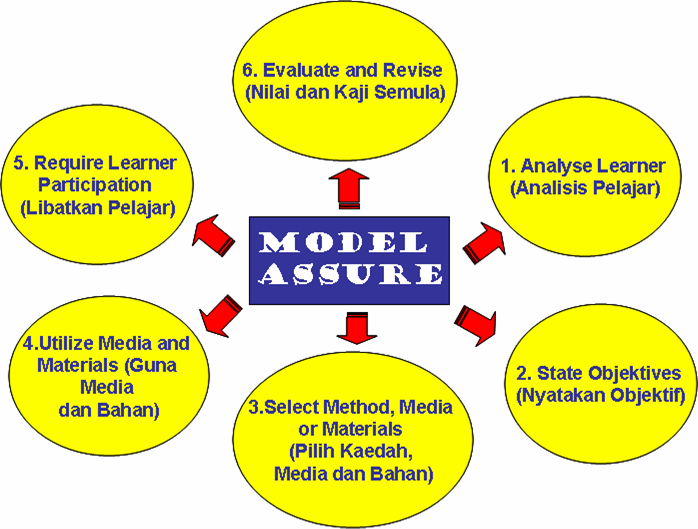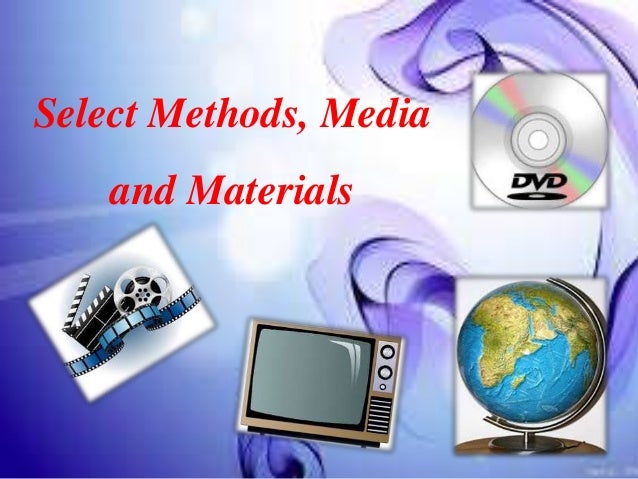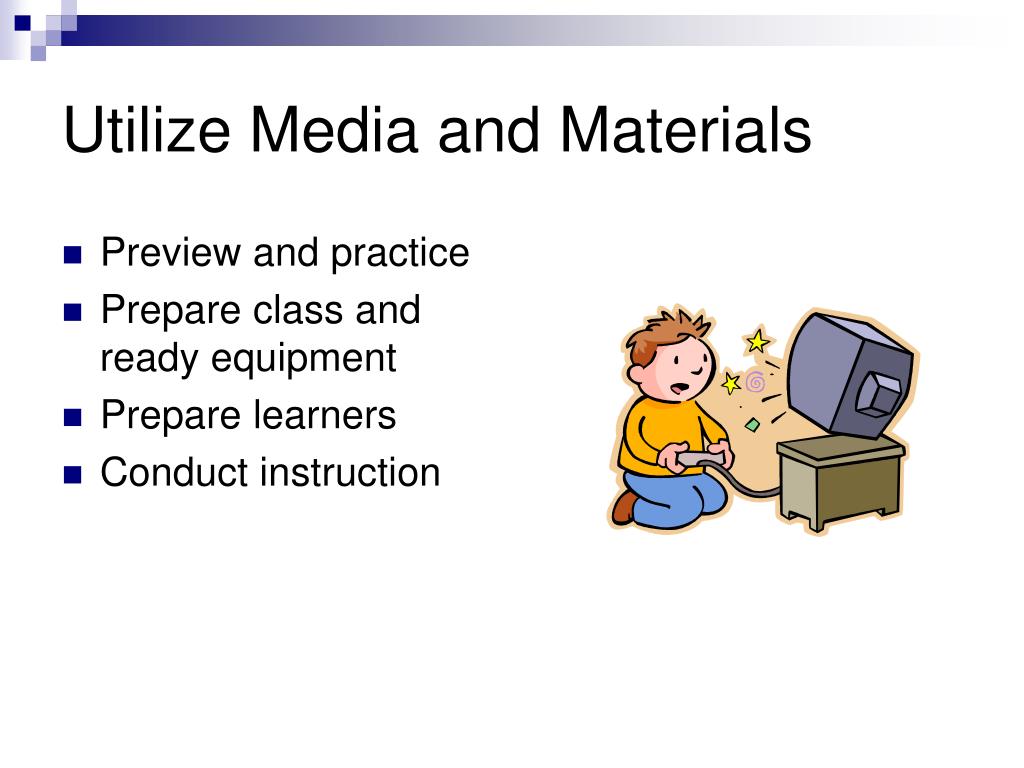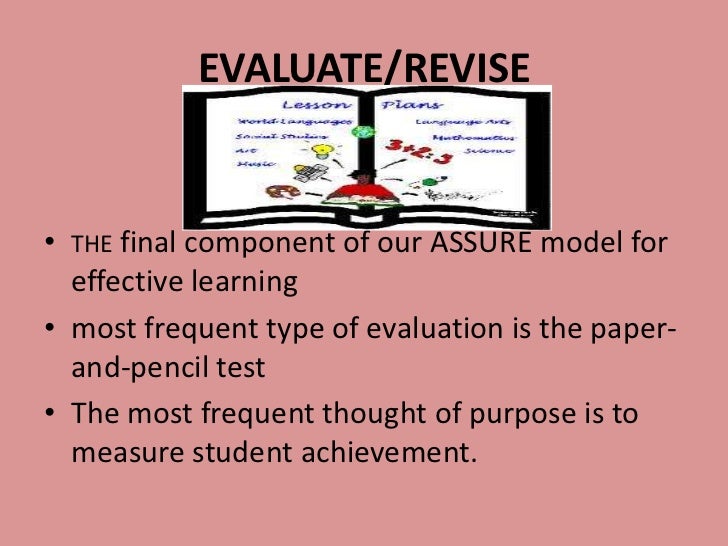The ASSURE model is a procedural guide for planning and conducting instruction that incorporates media and technology-assumes that training or instruction is required. The ASSURE model focuses on planning surrounding the actual classroom use of media and technology.
Actually the name of The ASSURE model is stands from :
- Analyze Learners
- State Objectives
- Select Methods, Media, and Materials
- Utilize Media and Materials
- Require Learner and Partisipation
- Evaluate and Revise
ANALYZE LEARNERS
The audience can be analyzed in terms of :
1. General Characteristic
2. Spesific Entry Competencies (Knowledge, Skills, and Attitudes about the topic)
3. Learning Styles
1. General Characteristic
General characteristic include broad identifying descriptors such as age, grade level, job or position, and cultural or socioeconomic factors.
2. Specific Entry Competencies (Knowledge, Skills, and Attitudes about the topic)
Preassessment measures, such as discussions and pretests, are also given before instruction but are used to measure the content to be taught-the target skills. If learners have already mastered what you plan to teach, you are wasting your timeand theirs by teaching it.
By analyzing what your audience already knows, you can select appropriate methods and media. For example, if you have a group diverging widely in entry competencies, consider self-instructional materials to allow for self-pacing and other aspects of individualization.
3. Learning Styles
Learning style variables discussed in the literature can be categorized as perceptual preferences and strengths, information processing habits, motivational factors, and physiological factors.
➤Perceptual Preferences and Strengths
Learners vary as to which sensory gateways they prefer using and which they are especially adept at using. The main gateways include auditory, visual, tactile, and kinesthetic.
➤Information Processing Habits
This category includes a range of variables related to how individuals tend to approach the cognitive processing of information.
➤Motivational Factors
A helpful approach to describing student motivation is Keller's (1987) ARCS model from the instruction. Keller describe four essential aspects of motivation :
1. Attention refers to whether students perceive the instruction as interesting and worthy of their consideration.
2. Relevance refers to whether students perceive the instruction as meeting some personal need or goal.
3. Confidence refers to whether students expect to succeed based on their own efforts.
4. Satisfaction refers to the instrinsic and extrinsic rewards students receive from the instruction.
➤Physiological Factors
Factors related to gender differences, health, and enviromental conditions are among the most obvious influences on the effectiveness of learning.
STATE THE OBJECTIVES
An objective is a statement not of what the instructor plans to put into the lesson but of what learners ought to get out of the lesson. An objective is a statement of what will be achieved, not how it will be achieved.
➢The ABCDs of Well-Stated Objectives
1. Audience
A major premise of systematic instruction is to focus on what learners are doing, not on what
the teacher is doing.
2. Behavior
The heart of the objective is the verb describing the new capability that the audience will have
after instruction. Better words include define, categories, and demonstrate.
3. Conditions
A statement of objectives should include the conditions under which the performance is to be
observed.
4. Degree
The final requirement of a well stated objective is that if indicates the standard, or criterion, by
which acceptable performance will be judged..
➢Classification of Objective
Classifying objectives is much more than an academic exercise for educational psychologist. Three categories of learning are widely accepted :
1. The cognitive domain is learning involves an array of intellectual capabilities that may be
classified either as verbal/visual information or as intellectual skills.
2. The affective domain involves feelings and values.
3. The motor skill domain is learning involves athletic, manual, and other such physical skills.
➢Objectives and Individual Differences
Objective in any of the domains just discussed, of course be adapted to the abilities of individual learners.
SELECT METHODS, MEDIA, AND MATERIALS
1. Deciding on the appropriate method for the given learning task.
2. Choosing a media format that is suitable for carrying out the method.
3. Selecting, modifying or designing spesific materials within that media format.
➣Choosing a Method
First, it would be overly simplistic to believe that there is one method that is superior to all others or that serves all learning needs equally well.
➣Choosing a Media Format
A media format is the physical form in which a message is incorporated and displayed. Media formats include, for example, flip charts (still images and text), slides (projected still image). audio (voice and music), video (moving images on a TV screen), and computer multimedia (graphics, text, and moving images on a monitor).
➣Selecting Available Materials
The majority of instructional materials used by teachers and trainers are "off the self" that is ready-made and available from school, district, or company collection or other easily accessible sources.
➣Modifying Existing Materials
If you can't locate entirely suitable materials and media off the self, you might be able to modify what is available. This can be both challenging and creative terms of time and cost, it is a more efficient procedure than designing your own materials, although the type and extend of necessary modification will, of course, vary.
➣Designing New Materials
It is easier and less costly to use available materials, with or without modification, than to start from scratch. There is seldom for reinventing the wheel.
Certain basic elements when designing new materials :
1. Objectives
2. Audience
3. Cost
4. Technical Expertise
5. Equipment
6. Facilities
7. Time
UTILIZE MATERIALS
UTILIZE MATERIALS
1. Preview The Materials
Always preview instruction materials before using it, the materials should be appropriate for your audience and objectives.
2. Prepare The Materials
You need to prepare the media and materials to support the instructional activities you plan to use.
3. Prepare The Environment
Whenever the learning is to take place in the class room, in a laboratory, or whatever the facilities will have to be arranged for proper student use of the materials and media.
4. Prepare The Learners
A proper warmup, from an instructional point of view, may be similar to one of the following :
1. Give a broad overview of the content of the lesson
2. Tell how the lesson relates to the topic being studied
3. Give a motivation statements that creates a need to know by telling learners how they will profit
from the lesson
4. Give cues directing attention to spesific aspects of the lesson
5. Provide The Learning Experience
Instruction should be able to direct attention in the classroom. Showmanship is part of the facilitators' job.
REQUIRE LEARNER PARTICIPATION
Educators have long realized that active participation in the learning process enhances learning. In the early 1900s John Dewey urged reorganization of the curriculum and instruction to make student participation central. Later, in the 1950s and 1960s, experiments employing behaviorist approaches demonstrated that instruction providing for constant reinforcement of desired behaviors is more effective than instructionin which responses aren't reinforced.
All perspectives also emphasize the importance of feedback (productive critical evaluative response):
➧Behaviorists, because knowledge of correct response serves as a reinforce of appropriate
behaviors
➧Cognitivists, because information about results helps to enrich learners' mental schemata
➧Constructivits, because meaning (and knowledge) is enhanced with each personal experience
➧Social Psyhologists, because interpersonal feedback provides both corrective information and
emotional support
The implication for designers and instructors is clear. The most effective learning situations are those that re-quire learners to practice skills that build toward the objective. The form of the participation may include practicing new spelling or vocabulary words, solving math problems on a worksheet, rehearsing a basketball play, or creating an original product, such as a term paper.
In all cases, learners should receive feedback on the correctness of their response. The feedback may come from the teacher or students may work in small groups and give one another feedback.
EVALUATE AND REVISE
EVALUATE AND REVISE
1. Evaluation Of Learner Achievement
➢The method of evaluating achievement depens on the nature of the objective
➢Objectives that focuseson cognitive skill, for example, distinguishing adjectives from adverbs,
describing a company's absence policy lend themselves to conventional written tests or oral
examination.
2. Evaluation Of Media and Methods
➢Evaluation also includes assessment of instructional media and methods.
➢Particulary after first use, instructional materials need to be evaluated to determine if future use.
with or without modification, is warranted. The results of your evaluation should be entered on
your personal file form.
3. Evaluation Of The Instructional Process
➢Although ultimate evaluation must await completion of instructional unit, evaluation is on going
process.
➢Evaluation are made before, during and after instruction.
➤Revision
1. The final step of the instructional cycle is to sit back and look at the results of your evaluation data
gathering.
2. If your evaluation data indicate shortcomings now is the time to go back to the faulty part of the
plan and revise it.
3. The model works, but only if you use is to upgrade the quality of your instruction constantly.
➢Particulary after first use, instructional materials need to be evaluated to determine if future use.
with or without modification, is warranted. The results of your evaluation should be entered on
your personal file form.
3. Evaluation Of The Instructional Process
➢Although ultimate evaluation must await completion of instructional unit, evaluation is on going
process.
➢Evaluation are made before, during and after instruction.
➤Revision
1. The final step of the instructional cycle is to sit back and look at the results of your evaluation data
gathering.
2. If your evaluation data indicate shortcomings now is the time to go back to the faulty part of the
plan and revise it.
3. The model works, but only if you use is to upgrade the quality of your instruction constantly.
Source : Heirich, Molenda, Russell, Smaldino et. All, 2002. Instructional Media and Technologies For Learning Volume 7. California: The University of California.








Tidak ada komentar:
Posting Komentar